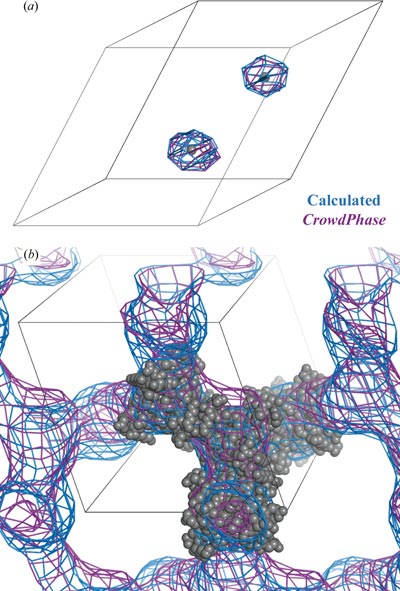Crowdsourcing the phase problem

There are many problems, however, where computational speed alone is insufficient to find a correct or optimal solution, for example because the parameter “space” cannot be fully searched in a practical time.
In contrast, the human mind can formulate expert knowledge specific for particular problems, providing a capacity to guide more efficient searches, although with more limited processing speed.
The power of the human contribution can be multiplied through the efforts of a greater number of individuals. The term `crowdsourcing', which combines the two domains of human and electronic computing, was coined in 2006 and since then has seen its definition broadened to a wide range of activities involving a network of people.
A challenging problem that might benefit from crowdsourcing is the phase problem in X-ray crystallography. Retrieving the phase information has plagued many scientists for decades when trying to determine the crystal structure of a sample.
In a diffraction experiment, the observed diffraction pattern allows measurement of the amplitudes of the reflection structure factors (as the square root of the intensities) but not their phases. The amplitudes and phases are both needed to reconstruct an electron-density map (by Fourier synthesis) so that a model of the crystallized molecule can be obtained.
There are a number of ways currently scientists try to solve the phase problem, all with varying degrees of success.
Regardless of the particular approach, most attacks on the phase problem can be viewed as having two sub-problems. One concerns how a high-dimensional space (i.e. of phases) can be efficiently searched, while the other concerns how a good solution can be recognized.
Crowdsourcing may be a route to solving these sub-problems [Jorda et al. (2014), Acta Cryst. D70, 1538-1548; doi:10.1107/S1399004714006427], here scientists have developed a game based on a genetic algorithm (a powerful search-optimization technique), where players control the selection mechanism during the evolutionary process (by recognising the good solutions).
The algorithm starts from a population of “individuals”, in this case a map prepared from a random set of phases, and tries to cause the population to evolve towards individuals with better phases based on Darwinian survival of the fittest. Players apply their pattern-recognition capabilities to evaluate the electron-density maps generated from these sets of phases and to select the fittest individuals.
The game called CrowdPhase (http://www.crowdphase.com) was applied to two synthetic low-resolution phasing puzzles and it was shown that players could successfully obtain phase sets in the 30 degree phase error range and corresponding molecular envelopes showing agreement with the low-resolution models.
Successful preliminary studies suggest that with further development the crowdsourcing approach could fill a gap in current crystallographic methods by making it possible to extract meaningful information in cases where limited resolution might otherwise prevent initial phasing.
Jonathan AgbenyegaBusiness Development Manager, IUCr
Media Contact
More Information:
http://www.iucr.org/news/research-news/crowdsourcing-the-phase-problemAll latest news from the category: Information Technology
Here you can find a summary of innovations in the fields of information and data processing and up-to-date developments on IT equipment and hardware.
This area covers topics such as IT services, IT architectures, IT management and telecommunications.
Newest articles

Bringing bio-inspired robots to life
Nebraska researcher Eric Markvicka gets NSF CAREER Award to pursue manufacture of novel materials for soft robotics and stretchable electronics. Engineers are increasingly eager to develop robots that mimic the…

Bella moths use poison to attract mates
Scientists are closer to finding out how. Pyrrolizidine alkaloids are as bitter and toxic as they are hard to pronounce. They’re produced by several different types of plants and are…

AI tool creates ‘synthetic’ images of cells
…for enhanced microscopy analysis. Observing individual cells through microscopes can reveal a range of important cell biological phenomena that frequently play a role in human diseases, but the process of…





















